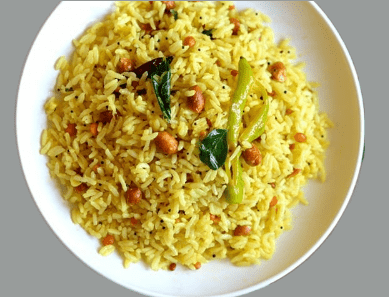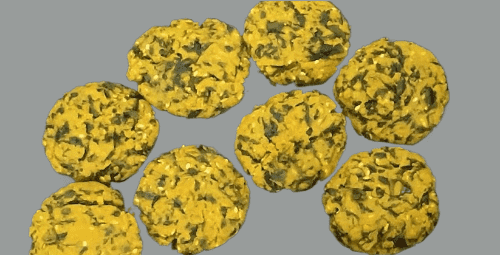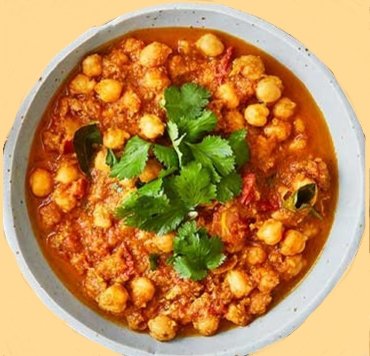Pulihora
Introduction :
Pulihora, also known as Tamarind Rice, is a quintessential South Indian dish celebrated for its tangy, spicy, and aromatic flavors. It is a staple during festivals, religious ceremonies, and special occasions, often served as part of a traditional meal or as an offering to deities. The name “Pulihora” comes from the Telugu word “puli,” which means tamarind, highlighting the primary ingredient that gives the dish its unique taste. In this comprehensive blog, we will explore the history, cultural significance, ingredients, step-by-step preparation, and variations of Pulihora, ensuring you have all the knowledge needed to create this delightful dish at home.

The Origins of Pulihora :
Pulihora has deep roots in South Indian cuisine, particularly in the states of Andhra Pradesh, Telangana, Tamil Nadu, and Karnataka. It is a traditional dish often prepared during festivals such as Ugadi, Pongal, and Navratri, as well as during weddings and other celebrations. The tangy tamarind base, combined with a blend of spices, creates a harmonious flavor profile that is both comforting and satisfying. Historically, Pulihora was made as an offering in temples, symbolizing prosperity and well-being.
Ingredients :
The key to making delicious Pulihora lies in using fresh and high-quality ingredients.
Main Ingredients :
- 2 cups rice (preferably Sona Masoori or any short-grain rice)
- 1 lemon-sized ball of tamarind
- 3-4 tablespoons sesame oil (or any cooking oil)
- 1/2 teaspoon turmeric powder
- Salt to taste
For the Spice Paste :
- 2 tablespoons sesame seeds
- 1 tablespoon chana dal (split Bengal gram)
- 1 tablespoon urad dal (split black gram)
- 1 teaspoon fenugreek seeds
- 5-6 dried red chilies
- 1 teaspoon mustard seeds
- 1/4 teaspoon asafoetida (hing)
For Tempering :
- 2 tablespoons sesame oil
- 1 teaspoon mustard seeds
- 1 teaspoon cumin seeds
- 2 tablespoons chana dal
- 2 tablespoons urad dal
- 2-3 dried red chilies, broken
- 10-12 curry leaves
- 2-3 green chilies, slit
- 1/4 cup roasted peanuts
- A pinch of asafoetida (hing)
Optional Ingredients for Enhanced Flavor :
- 1 tablespoon jaggery (to balance the tanginess)
- 1/2 teaspoon black pepper powder
- A handful of fresh coriander leaves, chopped
Preparation :
Step 1: Cooking the Rice :
Rinse and Soak: Rinse the rice thoroughly under running water until the water runs clear. Splash the rice in water for approximately 20-30 minutes. This helps in cooking the rice evenly and prevents it from becoming mushy.
Cook the Rice: In a expansive pot, bring 4 glasses of water to a bubble. Add the soaked rice and a pinch of salt. Cook until the rice is delicate but not overcooked. Each grain should be separate. Drain any excess water and spread the rice on a large plate or tray to cool. Drizzle a teaspoon of oil over the rice to prevent sticking.
Step 2: Preparing the Tamarind Extract :
Soak Tamarind: Soak the tamarind in warm water for about 15-20 minutes. Once it softens, extract the pulp by squeezing it with your fingers. Strain the pulp to remove any seeds and fibrous parts. Set aside the tamarind extract.
Step 3: Making the Spice Paste :
Broil the Ingredients: Warm a container over medium warm and dry broil sesame seeds until they turn golden brown. Remove and set aside. In the same pan, dry roast chana dal, urad dal, fenugreek seeds, dried red chilies, and mustard seeds until they are aromatic and golden brown.
Grind the Spice Paste: Allow the roasted ingredients to cool slightly, then grind them into a fine powder using a spice grinder or mortar and pestle. Add asafoetida and turmeric powder to the ground mixture. This spice paste will add depth and complexity to the Pulihora.
Step 4: Preparing the Tamarind Base:
Cook the Tamarind Extract: Heat 3-4 tablespoons of sesame oil in a pan. Add the tamarind extract and cook on medium heat until it thickens slightly and the raw smell of tamarind disappears. This may take about 10-15 minutes.
Add Spice Paste: Add the ground spice paste to the tamarind extract. Mix well and cook for another 5-7 minutes until the mixture thickens and the oil starts to separate. Add salt to taste.
Step 5: Tempering:
Heat Oil: In a separate small pan, heat 2 tablespoons of sesame oil. Add mustard seeds and let them splutter. Add cumin seeds, chana dal, urad dal, dried red chilies, and a pinch of asafoetida.
Add Aromatics: Add curry leaves, slit green chilies, and roasted peanuts. Fry until the dal turns golden brown and the curry leaves become crisp. This tempering adds a burst of flavor and crunch to the Pulihora.
Step 6: Assembling the Pulihora :
Mix the Rice: In a large mixing bowl or pot, combine the cooled rice with the prepared tamarind base. Mix gently to coat each grain of rice with the tamarind mixture.
Include Hardening: Pour the hardening over the rice and blend tenderly to combine. Ensure the tempering is evenly distributed throughout the rice.
Step 7: Final Touches :
Adjust Seasoning: Taste the Pulihora and adjust the seasoning if needed. You can add more salt, jaggery for sweetness, or black pepper powder for extra spice.
Garnish: Garnish with freshly chopped coriander leaves for a burst of color and freshness.
Serving Pulihora :
Pulihora is best served at room temperature, allowing the flavors to meld and develop. Here are some serving suggestions:
Classic Accompaniments :
Curd (Yogurt): A bowl of fresh curd pairs beautifully with the tangy Pulihora, balancing its flavors.
Papad: Crispy papad or appalam adds a delightful crunch.
Pickles: Traditional Indian pickles, such as mango or lime pickle, enhance the overall taste experience.
Presentation Tips :
Plating: Serve the Pulihora in a traditional banana leaf or a large platter, garnished with fresh coriander leaves.
Accompaniments: Place small bowls of curd, papad, and pickles around the platter for a complete meal experience.
Tips for the Perfect Pulihora :
Quality Ingredients: Use fresh and good-quality ingredients, especially tamarind and spices, to achieve the best flavor.
Rice Texture: Cook the rice to the right texture. It should be fluffy and separate, not mushy.
Tamarind Mash: Gurantee the tamarind mash is well-extracted and free of seeds and filaments. This will ensure a smooth and consistent tamarind base.
Balance of Flavors: Taste the tamarind mixture before mixing it with the rice. Adjust the salt, tanginess, and sweetness to your preference.
Temper the Oil: Use sesame oil for tempering as it adds a distinctive flavor to the dish. Ensure the oil is hot enough to release the aromas of the spices and curry leaves.
Cultural Significance and Variations :
Pulihora is more than just a dish; it’s a symbol of South Indian culinary heritage and cultural traditions. It holds a special place during religious ceremonies, festivals, and auspicious occasions.
Variations of Pulihora :
Andhra Pulihora: Known for its fiery spiciness, this variation includes extra green chilies and red chilies for a bold flavor.
Tamil Nadu Puliyodarai: This version often includes a bit of jaggery to balance the tanginess of the tamarind, and it is served as a prasadam (offering) in temples.
Karnataka Puliyogare: This variation uses a special Puliyogare powder, a blend of spices that adds a distinctive flavor to the dish.
Pulihora in Festivals and Religious Ceremonies :
Pulihora is an integral part of many South Indian festivals and religious ceremonies. It is often prepared in large quantities and distributed as prasadam to devotees. The dish symbolizes thriving, joy, and the divine blessings of the gods.
Health Benefits and Nutritional Information :
While Pulihora is a flavorful and indulgent dish, it also offers some nutritional benefits:
Nutritional Content :
Rice: Provides carbohydrates, which are a primary source of energy.
Tamarind: Rich in vitamins, minerals, and antioxidants. It aids digestion and adds a tangy flavor.
Sesame Seeds: High in healthy fats, protein, and essential minerals.
Peanuts: A great source of protein, sound fats, and basic supplement.
Health Considerations :
Moderation: Pulihora is relatively low in fat, especially if you use minimal oil. However, moderation is key, as the dish can be rich due to the tempering.
Vegan and Gluten-Free: Pulihora is naturally vegan and gluten-free, making it suitable for a wide range of dietary preferences.
Customizable: You can adjust the spice levels and ingredients to suit your taste and dietary needs.
Troubleshooting Common Issues :
Even experienced cooks can encounter issues while making Pulihora. Here are some common issue and solutions:
Rice Clumping Together :
Proper Cooling: Spread the cooked rice on a large plate or tray to cool. Drizzle a teaspoon of oil to prevent sticking.
Right Cooking Method: Use the absorption method for cooking rice, ensuring it remains fluffy and separate.
Too Tangy or Sour :
Balance Flavors: Add a small amount of jaggery to balance the tanginess of the tamarind. Taste and adjust the seasoning accordingly.
Bland Flavor :
Spice Paste: Ensure the spice paste is well-roasted and aromatic. It adds depth and complexity to the Pulihora.
Tempering: Proper tempering with mustard seeds, curry leaves, and other spices enhances the overall flavor.
Too Dry :
Oil Quantity: Ensure you use enough oil for the tamarind mixture and tempering. This prevents the Pulihora from becoming too dry.
Conclusion :
Pulihora is a timeless South Indian dish that brings together the vibrant flavors of tamarind, spices, and rice. It is a dish that evokes memories of festivals, celebrations, and family gatherings. By following this detailed guide, you can master the art of making Pulihora at home, bringing a taste of South Indian tradition to your kitchen. Enjoy the tangy, spicy, and aromatic delight of Pulihora, and share it with your loved ones as part of a memorable meal.





